
ISSN 0964-5640
And Innovative Computer Applications

Letters 3
Merging Ordinary Logistics with Hoffensteadt Logistics John de Rivaz, & Mal Lichenstein 5
What Is The Fractalated Curriculum? Harold J. McWhinnie 7
Ordering Time Ideas. Yvan Bozzonetti 8
Book Review: The Muse in the Machine Robert C.W. Ettinger 13
Magic Squares John Greening 14
On The Use Of Moduar Group Procedure To Express The Klein Hyperbolic Model As A Fractal Roger Bagula 15
Hyperbolics John de Rivaz 16
On The Track of M Bacteria Yvan Bozzonetti 18
Fractal Report is published by Reeves Telecommunications Laboratories,
West Towan House, Porthtowan, Truro, Cornwall TR4 8AX, United Kingdom.
Volume 6 no 34 First published August 1994. ISSN 0964-5640.
Call for Papers
The article pile is nearly empty, so readers are requested to get their thinking caps on again. Remember that we now cover other unusual computer applications, not just fractals. (But no games, business applications etc.)
Editorial
As I write there is a series of rail strikes, and this makes me ponder the conjecture that chaos theory tells us that it is impossible to control an economy with any degree of precision. Suppose that any group of people get a pay rise. That is iterated into other groups' cost increase, in this case a pretty basic cost of getting to work. Because the other groups' costs go up, they too go on strike for more pay and so the iteration continues.
Because it is easier to strike for more pay than to use some other form of violence to achieve lower costs (eg mass demonstration of using the railway without buying a ticket, or using some form of fraud to use a cheaper ticket than that required for your journey) there is a direction to the iteration of increasing costs and reducing efficiency.
In the UK we will shortly be seeing a change of government, and with it a change of the laws concerning "industrial action". It is probable that it will once again be easier to strike for more pay. However suppose some mechanism were introduced that enabled people to use similar levels of force to achieve lower costs. Suppose action could be taken against rail fares, or Council Tax, or insurance premiums or whatever.
Instead of leading to more inflation and inefficiency, this would lead to deflation and greater efficiency and make any economy using this system more competitive in the world.
The previous government tried to use unemployment as a means to this end, and after an apparent initial success they burned out and are now regarded to have failed. I suggest that some mechanism whereby people can strike at costs rather than income may achieve a similar result.
Global 2000
Enclosed with this issue, on the reverse of your mailing label, you should find a flyer for a scheme called "Global 2000". These schemes have made some early members money, but in the end they peter out. It is a pure gamble and should be treated as such, ie if you think gambling unethical then don't join. In favour of this particular example of these schemes are the facts that
it started on 1 June 1994,
the stake of �17.50 per position is low, and
you don't have to recruit people yourself to earn the projected return.
However it is a gamble, therefore don't put up more than you can afford to lose. Personally I would judge the risks to be higher than with stock market investment and lower than racing bets, raffles or lotteries.
An End for the Amiga?
According to The Greenweld Guardian of June, 1994 Commodore International have gone into voluntary liquidation. The paper said "That a company of this size and longevity should fail seems surprising, especially as they had been selling their Amiga and CD32 machines quite successfully."
However the receivers will continue to run the company in the hope of finding a buyer for it as a going concern. The Greenweld Guardian feel that on the figure it is unlikely that anyone would want to take it on.
The Greenweld Guardian is a newsletter run by Greenweld Electronics, suppliers of surplus electronic and computer components. They sell electronics parts and recently outdated software. Recent offers have included DOS 5.0 for �2, and obsolete computers such as the 286 PC for �40 or �60 with a hard disk. They also offered the Lexowriter word processor complete for �25. The snag was that there was no software! But you got a monitor/cpu/twin disk unit and keyboard for this trivial sum. If you knew where to get the software, then you had a bargain. [Greenweld Electronics 27F, Park Road Southampton SO15 3UQ]
More Translight
Mr Roger Bagula's September issue of The Fractal Translight Newsletter arrived here late May.
It started with a couple of articles on general topics, one being the frequency of occurrence of particular mintings of coins in small change, the other being Observations made on a dance floor, possibly in answer to my article about singles listings sheets that appeared in an earlier issue.
The serious stuff included Venn Diagrams and then many articles about various transforms, mappings and iterations produced by Mr Bagula's mathematical ideas. Certainly there were some original patterns, but I must say that i spent some hours trying to reproduce Fuzzy recursion of the second type and was not able to replicate the pattern shown. I should have thought that the Amiga program should map to a PC one!
If the Amiga does go out of production this will be bad news for this newsletter in the long run, although there are enough examples of the machine about to keep the machine popular for some while yet. Also, once the machine is declared obsolete new ones will be sold off at very low prices as with the QL and other defunct equipment.
I would also comment that the reduction of the typeface only works when the original is a good one. At least for the program listings, a bigger typeface leads to fewer copying errors when trying to type it in. A reader knowing nothing about BASIC would be unable to type these listings in, as he couldn't work out what various splodges are meant to be.
The above comment also applies to the October issue, received on 28 June. The front page was in colour, and well set out and clearly printed, although there was also a black and white copy of this page. This may imply that the colour version was for my benefit only. Certainly a lot was lost in the optical colour to monochrome transformation. Converting from colour to monochrome is better performed on screen with a program like PhotoFinnish, so you can alter a few shades of grey to get the best result.
The October issue also included some poetry and a short story by Mark Scott Bagula. I would definitely be inclined to reduce the amount of material in favour of better reproduction if I were publishing this newsletter. Mal Lichenstein's fuzzy logic program, for example, was unreproduceable due to photocopy blobs.
Important Announcement
Unless there is any serious objection, I propose from 1995 onwards to publish Fractal Report with 32 pages/issue and quarterly. There will then be 128 pages/volume instead of 120. The price will remain the same. This will save airmail postage for the overseas issues, as the minmum weight for printed papers was increased form 60g to 100g. 60g of printed papers was therefore extortionately expensive, and surface mail has been too slow at a possible 12 weeks.
From Mr John Reece
In spite of imaginary waning of interest in fractals, there has been a real surge of fractal generators for the Commodore Amiga recently. Programs like Winblend, MandelSquare, Man 2000, Mandelplot, Lyapunovia, and finally, at long last Fractint has been ported to the Amiga, together with Fracxtra, and it seems to work very well. Most of these programs will need Workbench 2.0 or better. I am sure that you handful of Amiga subscribers would be interested, and I would willingly supply further details upon request.
From Dr Hugh Daglish
Kaleidoscope needs some movement, and here it is in Quick Basic:
REM from Fractal Report 33 page 16
REM By Mal Lichtenstein
REM Modified by Hugh Daglish, 9 June 1994.
REM QuickBasic 4.5
SCREEN 9
DIM clone%(16)
LOCATE 23, 1
PRINT "HND 9.6.94"
RESTORE
DATA
0,9,10,11,12,13,14,15,21,37,53,39,36,45,55,62
FOR cl% = 0 TO 15
READ clone%(cl%)
NEXT cl%
FOR cl% = 0 TO 15
PALETTE cl%, clone%(cl%)
NEXT cl%
scalz = 161: scali = 113
dz = 1! / scalz: di = 1! / scali
LOCATE 23, 1
PRINT "Kaleidoscope"
FOR iz = -1 TO 1 STEP di
FOR rz = -1 TO 1 STEP dz
u = rz: z = iz
FOR j = 1 TO 10
uu = u * u - z * z
z = ABS(2 * u * z)
u = ABS(uu)
u = SIN(u + SQR(u))
z = SIN(z + SQR(z))
IF (u * u + z * z) > 1 THEN GOTO
endloop
NEXT j
endloop:
chrom% = 1
IF iz > 0 AND rz < 0 THEN chrom% = 2
IF iz < 0 AND rz < 0 THEN chrom% = 3
IF iz < 0 AND rz > 0 THEN chrom% = 4
IF iz > 0 AND rz > 0 THEN chrom% = 5
IF j MOD 2 = 0 THEN col% = chrom% ELSE
col% = 1
PSET (scalz*(rz+1)+145, scali*(iz+1)+50),
col%
NEXT rz
NEXT iz
LOCATE 23, 1
PRINT "Hit 'q' to stop "
DO UNTIL INKEY$ = "q"
carry% = clone%(2)
FOR cl% = 3 TO 15
clone%(cl% - 1) = clone%(cl%)
NEXT cl%
clone%(15) = carry%
FOR cl% = 0 TO 15
PALETTE cl%, clone%(cl%)
NEXT cl%
LOOP
SCREEN 0
END
From Mr Peter James
You might be interested to know that simultaneous to the paperback publishing of my novel Host on 3 November Penguin are publishing it also as their first ever electronic novel on floppy disk, compatible for both PCs and Macintoshes. It will feature myself giving a personal introduction to the novel, annotations to the text explaining cryonics and other technical aspects, as well as some fun things such as the computer Archive actually speaking! There is also going to be a competition, details to be finalised, in which readers can win a laptop computer.
Comment
In many respects, this novel is more about computers than cryonics. In particular, the man machine interface and computer assessment and archiving of human activity are the main features. The ideas are based upon actual research work at Xerox on computer archiving of office activity.
Political trends today require detailed assessment of work performance in many fields. At present, time and job satisfaction are lost by the need to fill in forms for various forms of audits. The system also fails because it is easy for people with no pride in their work who want to do the barest minimum possible apparently to get good results by being good form fillers.
This can be solved by a totally transparent system of computer monitoring, although many people will complain about being spied on. The novel 1984 with its "telescreens" was totally impracticable - who watches the watchers? There are already some assessment systems in force, the most well known is the Tachograph for lorry drivers. (Unlike doctors, their hours of work are limited for safety reasons.)
A large part of Host concerns the development of such a computer monitoring system (and what can go wrong!)
with Hoffensteadt Logistics
by John de Rivaz, from an Amiga program by Mal Lichenstein
Mal Lichenstein sent in a batch of Amiga programs, and this one caught my imagination.

After typing it in as is, I could see that much more could be made of the idea by trying the following TurboBasic program, which produced the image to its right:
screen 12 d%=0 x1=-.8 y1=-.8 x2=1 y2=1 xstep=(x2-x1)/640 ystep=(y2-y1)/480 for b=y1 to y2 step ystep incr d% c%=0 for a=x1 to x2 step xstep incr c% x=a:y=b:r1=3.99:r2=.99:black=0 for n%=1 to 20 e=(r1*x*(1-x)):e=e*e f=r2*(1-2*abs(y-.5)) x=e-f*f+a y=2*e*f+b if instat then end if x*x+y*y>4 then black=1:exit for next n% col%=(n% mod 15+1)*black pset (c%,d%),col% next a next b
Changing x2 and y2 to 2 produced the display shown on the next page. Fractint's formula has the advantage that it can produce zooms and other changes without any more work, so the program was then put into this. I expect that I have used some rather roundabout methods to get the result, and maybe someone else can make it more sanitary.
MergedLH = { z=pixel x=real(z) y=imag(z) a=x b=y: e=p1*x*(1-x) e=e*e f=p2*(1-2*abs(y-.5)) x=e-f*f+a y=2*e*f+b z1=(0,1) z2=x+z1*y, |z2|<=4 }
Fractint formulae also produce correct aspect ratios, which the simple BASIC program does not, as can be seen from the Fractint printout. I loaded it into PhotoFinish, and messed about with the colours a bit to get the best monochrome image. (Don't forget the : and , when typing it in!)
There has been some controversy about the validity of merging mathematical formulae - Roger Bagula has also come into some flack over this. But the results do seem interesting to look at if nothing else!
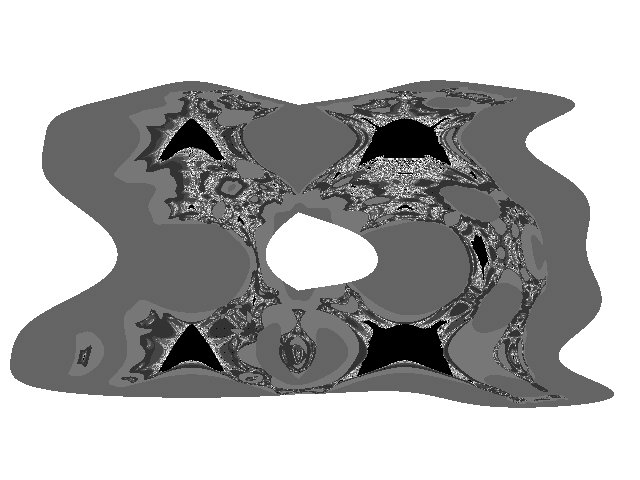
What Is The Fractalated Curriculum?
by Harold J. McWhinnie
Chaos Seen As A Metaphor For The Creative Process In The Arts.
The purpose of this project is to explore the links between science and art, the goal is to produce art by an examination of the motivations and aesthetic positions of the fields involved.
Theoretical science seeks to generalize from measurements, the motivation in art is to particularize; the art work functions as an integrated whole. Artists involved in technology usually approach chaos and fractal ideas as sources for tools and inspiration. The logical structure behind those tools is not very relevant to their basic purposes.
The tools fractal geometry can provide are psychological models of aesthetic perception.
Research from the following areas will be used as the knowledge base for this general effort.
1. Chaos Complexity Theory
The cosmological view
This will be the big picture, the major frame of reference for the research and the curriculum to be based on these ideas. The basic source will be Gleich's book Chaos.
2. Fractal Geometry
The language of chaos
In this area we shall use the work of Clifford Pickover. In addition we shall introduce the ideas of Mandelbrot however the emphasis will not be on the mathematics.
We will use several software programs to expand fractal images such as Fractal Vision and Fractint.
3 The Nature Of Symmetries
The visual form of chaos
Here we will use the work of Hargarti and explore the nature of symmetry in nature, in mathematics, science, and in art topics.
Fourfold symmetries
Fivefold symmetries
4 The Golden Section And Dynamic Symmetry
The classical dimension of chaos
Here we shall look at the work of Jay Hambidge and explore the ideas of dynamic symmetry as a key to the question of the golden section and the basic ideas in the classical conceptions of order and complexity.
5 The Nature Of The Brain
The human dimension of chaos
According to some linear memory is fractal. It consists of clusters within clusters within clusters. The layers of memory are self-reflected, the images of memory of self-similar.
In a sense chaos here will be explored as a metaphor.
6 Drawing With The Whole Brain
The aesthetic dimensions of chaos
Here we will explore ideas of drawing which are directly connected to the nature of the brain.
Harold J. McWhinnie
2311 H.R. Benjamin Building
University of Maryland
College Park
Maryland 20742-1175
U. S. A.
Email:
[email protected] (hm9)
Comment: I am not quite sure whether Mr McWhinnie is offering a course, or just comments on a proposed course. Either way, readers interested are invited to make contact. There are certainly some thought provoking ideas here.
by Yvan Bozzonetti
Shortly after its publication in 1915 by Einstein, the general theory of relativity was extended by a young physicist, Kalusa, into a five dimensional domain to include electromagnetism. Nobody, including Einstein himself was able to find any error in that form of the theory. On the other hand, it implied no new phenomena and no extension of the Maxwell form of electromagnetism.
Few years after, the discovery of quantum mechanics jeopardized the theory, until Klein demonstrated a quantised form of it. That Kaluza-Kleinform of relativity didn't survive for long. The discovery of weak and strong nuclear forces undermined it for more than half a century.
The subject came to light anew in the seventies with the advent of two new concepts: gauges and strings.
The name "gauge" comes from a proposal by Weyl in the twenties. He assumed than the physical dimensions of objects was defined locally by what he called a gauge field. The false nature of that concept was demonstrated shortly after.
On the other hand, in mathematics, the theory of fibre bundles allows one to turn length into angular measures and vice-versa. A gauge length may then become a rotation or phase shift in the wave function of a quantized field. For example, electromagnetic fields can be defined as the effects of a vector potential at each point of a four dimensional space. When the wave associated with that field undergoes a phase shift at a point, it translates into an electromagnetic interaction at that point. In the electromagnetic case, that phase shift may be pictured as a plane rotation with a single axis. From here comes the name of the mathematical symmetry implied: U(1) Unitary one dimensional transform.
That theory was so successful that theoretical physicists undertook many attempts to apply that formalism to other fields. A first success was registered by Salam and Weinberg when they demonstrated than the weak nuclear force may be united with electromagnetism with a two axis phase shift. The mathematical symmetry is then called SU(2) Special Unitary two dimensional transform.
Nearly at the same time, building on the ideas of Gellman and some other, many physicists came to the concept of a three axis gauge rotation to define the strong nuclear force. This is the so-called Quantum Chromo Dynamics (QCD) theory of quarks and gluons with symmetry SU(3).
In another domain, progress in differential geometry understanding demonstrated than the simplest object in a space is not a point but a line. Taken into physics theory, that translated into the idea that as "elementary" particles are not the simplest thing in the world, there must be tiny line or strings at a more fundamental level. When that suggestion was mixed with the quantum laws, the result was somewhat startling: The theory contradicted itself in most cases. To escape that situation, the world needed either eleven or twenty-six dimensions. Eventually, a twist in the theory was able to reduce the 26 parameters to only ten dimensions. The eleven case asked for two time dimensions, or ten dimensions too if the extra time is put aside.
Here enters the simplest mathematical concept: If the gauge axes are understood as Kaluza-Klein dimensions, then, to account for all known physics, the four dimensions of classical general relativity must be supplemented by: one dimension for U(1) field, two for SU(2) electroweak field and three for QCD. The sum 4 + 1 + 2 + 3 amounts to ten, exactly the value asked for by string theory. Is that a mere chance? Nobody knows.
In the eighties the situation became a step more complicated. It was realized that strings are only one particular case of all possible topological "defects" in a space. In N dimensions, there may be defects with any number of dimensions from zero up to N minus one. In topology, all defects with the same number of dimensions are equivalent to each other. From our four dimensional viewpoint, four case may be theoretically observed: The zero dimensional defect or monopole, the one dimensional one is the string seen before; in two dimensions there are domain walls, a speciality first pointed out by Thorn from U.C.L.A. The last entry in the set in known under the name of texture, or three dimensional defect. Recent works seem indicate than the galaxy distribution at large responds to texture defined theories.
Even restricted to strings, the world seems very strange. Where are the six space dimensions of gauge field and their second time? The question was on the table from the start of the theory when Kaluza extended relativity in five dimensions. Its answer was than the unseen dimension was too small to be noticed. Here, the Universe must reduce at one natural unit of length or near ten power minus thirty three centimetres, one hundred of billions of billions of times smaller than a nuclear particle. Modern physicists say the same thing for the six dimensions of gauge space. Why is it so?
The answer may rests in the nature of time. In special relativity, time is the fourth dimension. On the contrary, that is not a requirement for general relativity where all four dimensions are worked in the same way, without special properties for the last one. Here, time may be seen not as the fourth dimension, but simply a tangent parameter to it, a differential in the mathematical language. Tangent quantities are straight line or plane ... So, time may be understood as a "linearizer", it allows the suppression of curvature at large scale from the dimensions undergoing its action.
Strings need two time dimensions to see nine space ones, we know the first time allows to see three space dimensions, the second must open the other six. We do not see this world because its time remains frozen for us. In the string world, when one time is singled out, the space shrinks to three or six dimensions, depending on the chosen time.
Actually, the situation is slightly more complicated, even a single time parameter may be far more complex. That is so because strings are in fact, superstrings. The name comes from supersymetry, a theory first proposed for particle-like objects.
Particles in physics display a number of symmetries between their properties. One such property is the spin, or symmetry after rotation. Spin is counted in quantum unit of angular momentum. One unit of spin is equal to a full turn. All particles have spin defined by whole number or half numbers, for example: 0; plus or minus one half; 1; + or - 1 1/2; 2; and so on. Spin is not hard to understand. If a checker token is flipped over, it looks the same; a half turn later it in the same "state". On the contrary, a flipped coin does not looks the same, its spin is one. Take a dish in your hand with a glass full on it, to turn it without spillage need two full turns, or a spin of two. In particle physics, a token cannot be exchanged for a coin. Whole and fractional spins give different properties and there is no symmetry to convert a kind into another.
The theory goes one step further than present day experiments and allows such a transformation. That more general symmetry is called sypersymetry. There is no possible supersymetry theory of particle fields with spin larger than two. beyond that value, point-like particle objects have no meaning, this is the string domain.
Even a single time with point-like particles or events in the language of relativity, must allow supersymetric states with spins up to two. In the most general case, the so-called N8 supersymetry, there are 72 different spin states with values from zero to two. Clearly, our time allows only one kind of zero spin state. We are not, or we do not see the N8 supersymetry. That is not surprising at all: underneath strings or one dimensional topological defects, there is room for the zero dimensional defect called monopole, and we do not see monopoles. We are under that, in a defect free space-time. Here, supersymetry must reduce at the trivial N1 case with no supersymetry at all. The sole allowed state is a solitary spin zero one.
To summarize, from our space, we can see up to four topological defects with decreasing numbers of dimensions. Strings define the one dimensional defect and are the simplest objects with two time dimensions. To select a single time breaks the string world into two spaces, one with six dimensions, the other with only three. That one allows supersymetric states of events, tied to zero dimensional topological defect in the fabric of spacetime. Only a defect free space-time gives a single time with a single spin zero state for all its events.
Now, its time to get back to the original Kaluza proposal. If the U(1)dimension is introduced in the geometry of special relativity, that is, where the fourth dimension place is taken by its differential in the form of ordinary time, then we have a five dimension system with three space dimensions, one time and one empty dimension. Indeed at macroscopic scale, the folded U(1) dimension reduces to zero for all practical purposes. Its effect is to orient the space made up by the other dimensions.
In a geometry, when a vector is squared the sign of each square formed by its component give the signature of the geometry. In Euclidean geometry, all signs are +. for example, in three dimensions, the signature is: (+,+,+). The square of a vector with components x, y, z is then: x2+ y2 + z2. On the contrary, special relativity exploits a lorentzian geometry with signature: ( +, --, -, -) or in a holder form: (-, +, +, +). A vector: t, x, y, z gives then, with the last signature a square equal to: -t2 +x2 + y2 +z2. A further empty dimension produce a signature such that: (0,+,-,-,-) or (+,0,-,-,-); (+,-,0,-,-); (+,-,-,0,-); (+,-,-,-,0). The first and last case may be deduced from each other by a single circular permutation: the final element is taken up and put in front of the set. There is a way to see that double system as a matter-antimatter world. The second signature may be brought back to the preceding case with three circular permutations, this is a space with solvable defects in three dimensions, a texture. On the other hand, the zero dimension rests on the wrong side at the end. It does not disappear beyond the time component and remains in space. Texture destruction let a cinder made of monopoles or zero dimensional defects. No circular permutation can get rid of the last two cases, they define domain wall and string respectively, with one and two space dimensions beyond time. A second time dimension will be needed to recover them. There is no antimatter at this level and physicists call that property Majorana. If we want to work with that world, we need to seek after majorana particles such some nuclear mesons.
Well, all of that is not a mathematical proof, only a very simplified extract of a giant theory entangled in high mathematics.
The practical side of all that summarize in the following way: Topological defects in the space-time can be induced by the introduction of a supplementary empty dimension in special relativity; that dimension is the U(1) symmetry of electromagnetism. That don't say how to get access to the phenomenon but at least where to search for.
The last step asks for a way from five to four dimensional space, including quantum effects. Because we go from up to down, the starting point is a five dimensional quantum space, not a four dimensional one.
Quantum effects may be seen as the product of a force field acting only at short distance and linked to another long range field. From relativity, we know a long range force field is nothing more than the product of spacetime curvature. In four dimensions, that curvature gives the gravitation and in five, we add electromagnetism, following Kaluza's idea. With the fractal idea of scale invariance, we see the short range force field as a fractal effect of the long range one so, quantum world becomes a geometric product of space time.
Mathematically, a curved space-time is not scale invariant: it contains a quantity named metric operator with scale dependant properties. On the other hand, space continuity behaves in the same way as curvature in most respect and allows scale invariance.
In five dimensions, we can then picture space-time as a mist made up from very many small droplets without link between them. At large scale, we encompass many droplets and discontinuity does not reveal itself, the mist looks as a continuous body of water. At small scale, we need a particular, curved geometry to link each droplet to the next, that continuity requirement produces a local space-time curvature generating the quantum force field.
Five dimensional curvature is defined by a Riemann tensor with fifty essential coordinates. We are not in the true general relativity theory, curvature here comes from discontinuity of space, it is not a fundamental property of the world. We can then use a "weak" general relativity and broke the fifty components tensor into fifty tensors with only one component each. Such "tensors" are simply Gaussian curvatures in two dimensions, the five dimensional world is so reduced to fifty curved surfaces.
Quantum world uses "vectors" with half unit length, or spinors, an unit vector breaks then into a stack of two spinors . Each Gaussian curvature vector turns then in the quantum domain into a double spinor space or double quantification. Photon, the interacting particle of electromagnetic force field at quantum level is indeed the product of a double quantification. All the quantum electrodynamics theory is a double quantification system. So, QED as we know is one part in fifty of the five dimensional world.
So-called squeezed states of photons allow more quantifications and so pave the way towards five dimensional empty space. All of that make a link between present day physics and the strange world of double time superstrings.
Superstrings have two macroscopic times, in the quantum world, the five dimensional discontinuity produces far more of them. With 50 Gaussian curvature vectors, 100 spinors are generated with as many quantifications. Another way to see that is to limit the theoretical scope at two quantifications, and so the theory remains in the domain of mere quantum electrodynamics. Each more quantification may then be taken in the place of one of the first two. That looks as another quantum time. In that way, 98 more time parameters are added to our world. We have 99 times to look at! More than simple atoms in chemistry. There is room for a full science of quantum time chemistry.
Quantum theory predicts only what seems to be probabilities in the outcomes of any phenomena. What become the unrealized probabilities? In the Everett school, they belong to some parallel Universes. Here, they sink simply in other quantum times.
All of that seems very theoretical and without practical interest today. That is true ... today indeed. We start only to understand that domain of the physical world and useful technology asks for some time to come. Some day, when time chemistry will becomes a practical tool, we can extract from it any chosen probability. For example your cells may be dead in one quantum time and not in another (there will be always a time where they are alive). If that is done on every cell of a long ago deceased person, what will be the result?
Pondering on the nature of time is not without long term practical consequences after all.
Book Review The Muse in the Machine
by Robert C.W. Ettinger
Reprinted from The Immortalist. It has been very slightly edited to remove references to cryonics, which are not relevant to Fractal Report.
The above book is subtitled Computerizing the Poetry of Human Thought, and the author is Yale professor David Gelernter. [The Free Press, a Macmillan division, 1994]
I don't like either the title or subtitle, but I can recommend the book without reservation. Dr. Gelernter doesn't say many things in 200-odd pages, but what he says -- I believe -- is correct and useful, as well as interesting. The following main points emerge:
1. The mind is not a computer program. Emotion -- feeling -- is central to consciousness, and feeling requires hardware (or wetware), not just software. An abstraction cannot feel.
2. Human thought covers a spectrum from "high-focus" (logical) to "low-focus" (at the extreme, dreams and hallucinations). Creativity -- typically involving analogies and metaphors -- usually stems from mid- to low- focus thought.
And that's about it -- but it's sobering to realize that it does require (at least) a book-length exposition to clarify these points for most people.
NOT JUST PHILOSOPHY: What makes this author somewhat unusual is that he is actually engaged in development of artificial intelligence, and is said to be a leader in parallel processing.
He is not a neurophysiologist. He works from the top down, his aim being to create a machine that can imitate human thought, or produce results like those of human thought, without necessarily actually having any subjectivity.
NOT JUST THE BRAIN but the body is required for full consciousness, because of the interactions.
"TRANSCENDENCE", (as in some types of religious or "spiritual" thought) is a low-focus mental state in which one "knows" something or has an "immediate experience" without regard to logic. In other words, it is a kind of dream or hallucination (although the author did not express it that way).
PRE-SCHOOL CHILDREN aged three to four were better at producing metaphors than college students, or other children either older or younger. What is needed, apparently, is a lot of low-focus thought, along with adequate language.
DREAMS often occur before sleep. (I can verify this.) Low-focus thought, including dreams, may allow conjoining of experiences or ideas that produce similar feelings, producing analogies or metaphors that would not occur in high-focus thought.
Comment:
"any desired specification" means that you could put in the 41's of the original example and get the program to fill in the rest.
"using the principles of evolution" means that the program could generate magic squares at random using seeds. Those seeds that produced one nearly meeting the requirements of the user (eg with lines of 41s) could influence the next set of seeds used and so on until the wanted result occurred.
The program given only generates one magic square per number entered. There is no variation or point where it could be added. However it is a start!
More about The Muse in the Machine
On The Use Of Modular Group Procedure
To Express The Klein Hyperbolic Model As A Fractal
by Roger Bagula
My recent work with five space models has made me consider a more primitive model for a fluid particle. In three books I have the Klein Model or Klein hyperbolic model is discussed. Herman Weyl who I consider my mentor says in Space Time Matter (P93): Philosophers have put forward the thesis that the validity or non-validity of Euclidean geometry cannot be proved by empirical observations ... only the whole composed of geometry and physics that may be tested empirically. I think that fractal models allow a combination of physics and geometry to be empirically tested. For my Klein model I use the g(ij) that Weinberg uses on page 9 of Gravitation And Cosmology:
g(11)=a^2*(1-y^2)/d^2
g(22)=a^2*(1-x^2)/d^2
g(12)=g(21)=a^2*x*y/d^2
d=1-x^2-y^2 to get the orbits:
z(1)=g(11)*(x+i*y)+g(12)*(ca+i*cb)+|c|^2/z
z(2)=g(21)*(x+i*y)+g(22)*(ca+i*cb)+|c|^2/z
The third book that mentions the Klein model is Witter's Mathematics The Study of Axiom Systems. In comparing their arguments and trying to understand what they were talking about I found that Poincare's universe is an offshoot:
T=a^2-r^2
Since in much of my fractal work in the Kaluza-Klein fractal I use the iteration level k as temperature for the fractal fluid and have used a modified limit using this relationship. I think that the Klein Model is a natural for orbit type of Mandelbrot I have been doing.
The fractal of the Klein model is a simple way to view how a fluid-field would be distributed in a noneuclidean geometry of a four or more dimensional particle. This kind of approach is at a more primitive level of physics than group theory or even general relativity. I am a firm believer in testing your assumptions and seeing what really makes sense. The distance relationship that Weinberg and Weyl both give is Cayley hyperbolic inner production vectors ld using @ for dot
1=l@d+|l|*|d|*cosh(D(ld)/a)
That makes me ask if the outer product might be in that pattern:
0=l><d+|l|*|d|*sinh(D(ld)/a) { >< as cross product}
I will say that none of these authors tells or even mentions this second equation!The result gives a way to find D(ld):
(l@d+l><d)/|l|*|d|=cosh(D(ld)/a)+sinh(D(ld)/a)=exp(D(ld)/a)
or the expression:
D(ld)=a*log((l@d+l><d)/|l|*|d|)
That, friends and neighbours, is a computable if the components of the vectors are known. I've used a similar derivation to arrive at my Hilbert angle. So what am I getting at with this? The assumption of orthogonality is involved in this kind of derivation and any one who deals with weak fields finds that orthogonality may be fine for light and electromagnetic fields but weak fields seem more elliptical in their interactions. It has occurred to me that time may not be at strictly a right angle to space such that the product residues are not (1 and 0) as above but sine and cosine of some angle.
Since we observe with light those equations are fine in the old sense but if we observe by neutrinos or gravitational particles these laws may or may not apply. Classical Weinberg weak theory doesn't account for how small a number of neutrinos are actually observed. My guess is that some fundamental assumption about the nature of space-time is at fault. I have come to the conclusion that some sorts of matter may exceed the speed of light and as a result do not react with matter at the same rate as light. Neutrinos and the field transmission particles of gravitation are my best bet. My guess for their maximum velocity is c/(8*pi*G)^.25 or about 28*c. I am sure a lot of people will think this stupid since special relativity says matter is singular at c. In mathematics and fractal we deal with a lot of functions that are singular at points and don't think anything of looking past that point. It is consideration of even velocity as a complex number that allows one to think of matter at speeds exceeding light.
What has that to do with the Klein model? Well if light is the radius of the Klein plane then the fluids in the fractal are not bound by the light radius. Experimental mathematics showing that noneuclidean fluid physics must at least consider translight fluid distributions.
ROGER L. BAGULA MARCH 1992
by John de Rivaz
As Roger Bagula's article suggests a fractal from these equations, I typed the following into a Fractint frm file:
Klein1 Hyperbolic Model = {
z=pixel
x=real(z)
y=imag(z)
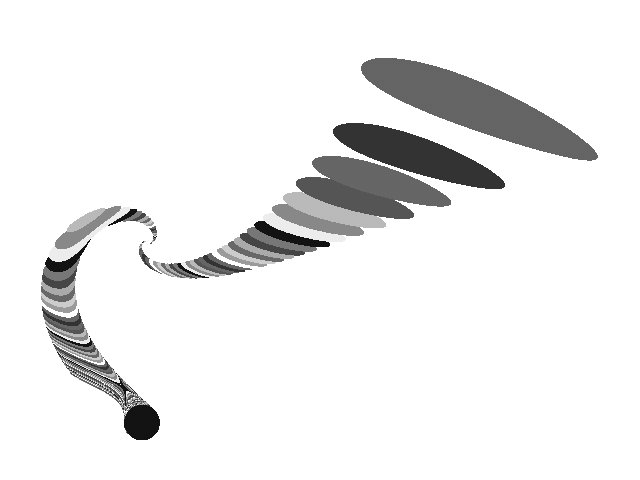 a=x
b=y:
x2=x*x:y2=y*y
d=1-x2-y2
d2=d*d:a2=a*a:a2d2=a2/d2
g11=a2d2*(1-y2)
g22=a2d2*(1-x2)
g12=a2*x*y/d2
z=g11*(x+i*y)+g12*(p1)+(|p1|^2)/z,
|z|<=4
}
Klein2 Hyperbolic Model = {
z=pixel
x=real(z)
y=imag(z)
a=x
b=y:
x2=x*x:y2=y*y
d=1-x2-y2
d2=d*d:a2=a*a:a2d2=a2/d2
g11=a2d2*(1-y2)
g22=a2d2*(1-x2)
g12=a2*x*y/d2
z=g12*(x+i*y)+g22*(p1)+(|p1|^2)/z,
|z|<=4
}
a=x
b=y:
x2=x*x:y2=y*y
d=1-x2-y2
d2=d*d:a2=a*a:a2d2=a2/d2
g11=a2d2*(1-y2)
g22=a2d2*(1-x2)
g12=a2*x*y/d2
z=g11*(x+i*y)+g12*(p1)+(|p1|^2)/z,
|z|<=4
}
Klein2 Hyperbolic Model = {
z=pixel
x=real(z)
y=imag(z)
a=x
b=y:
x2=x*x:y2=y*y
d=1-x2-y2
d2=d*d:a2=a*a:a2d2=a2/d2
g11=a2d2*(1-y2)
g22=a2d2*(1-x2)
g12=a2*x*y/d2
z=g12*(x+i*y)+g22*(p1)+(|p1|^2)/z,
|z|<=4
}
I make no assertions that it follows from Mr Bagula's equations - he doesn't actually say what a, b and c are. There also may be more elegant ways of using Fractint's complex variables to achieve the required result. Nevertheless, you do get some interesting pictures. Whether they show anything of ultimate significance about the meaning of life is up to the viewer!
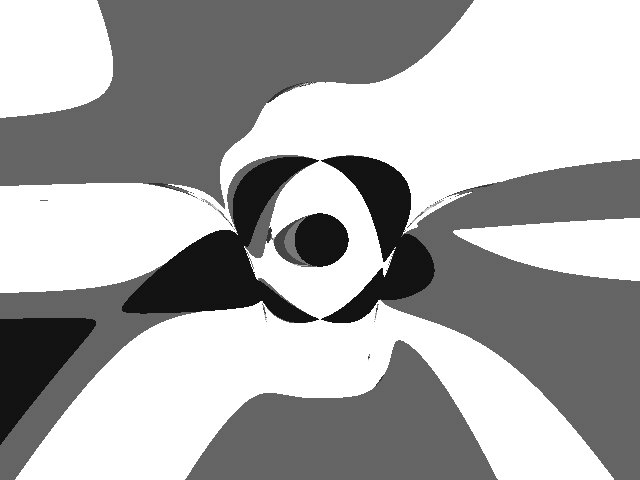
K2 (-32,24)-(32,-24)
P1=0
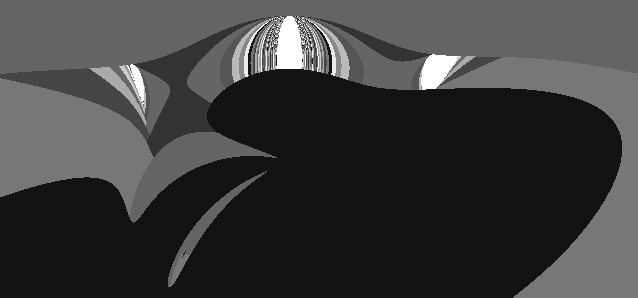
K2 (-.61,0.02)-(-.59,0.009)
P1= 0.9 + .1j

Part of
K2 (-2,2.35)-(2.4,0.07)
:P1=0.9+j
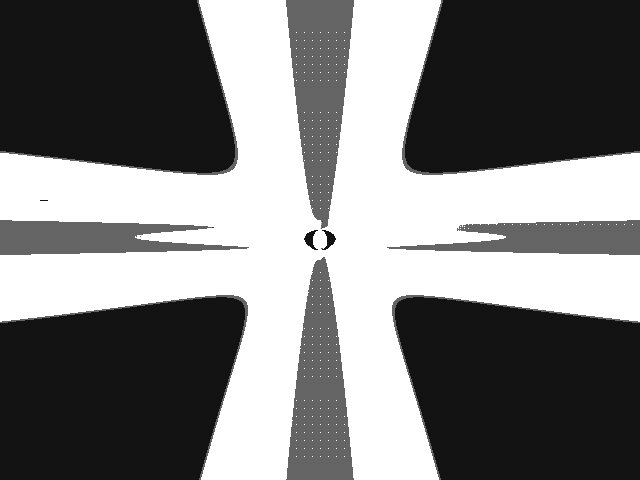 K1 (-32,24)-(32,-24), P1= 0.5+0.5i
K1 (-32,24)-(32,-24), P1= 0.5+0.5i
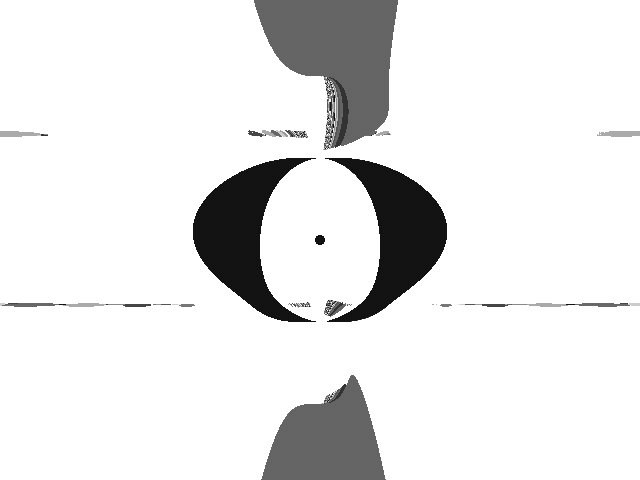 K1
(-4,3)-(4,-3),
P1=
0.5 +
0.5i
K1
(-4,3)-(4,-3),
P1=
0.5 +
0.5i
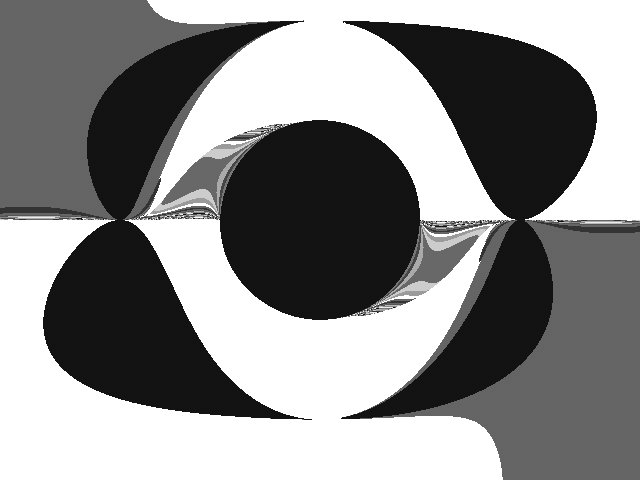 K2 (-1.6,1.1)-(1.6,-1.3), P1= 0
K2 (-1.6,1.1)-(1.6,-1.3), P1= 0
 K2 (-32,24)-(32,-24), P1= 0.3 + 0.321i
K2 (-32,24)-(32,-24), P1= 0.3 + 0.321i
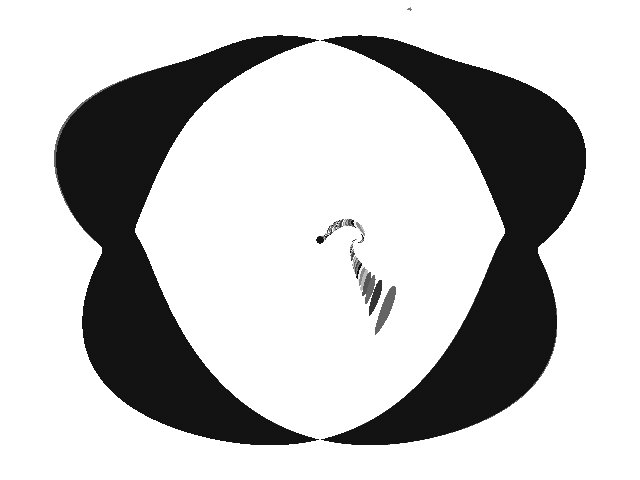 K2 (-1.6,1.2)-(1.6,-1.2), P1= -.3 - 0.321i
K2 (-1.6,1.2)-(1.6,-1.2), P1= -.3 - 0.321i
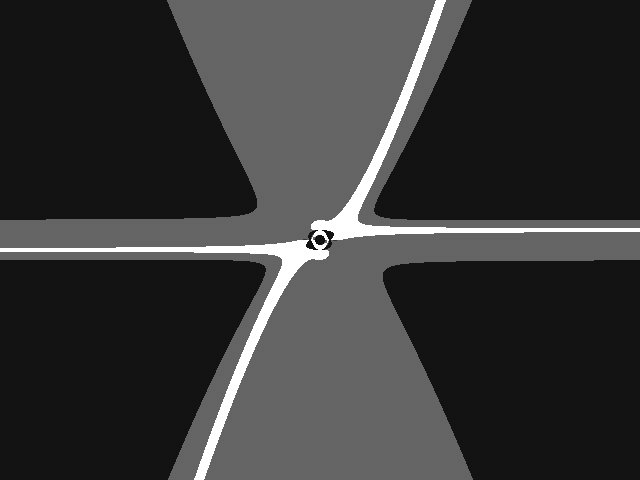 K2
(-4,3)-(4,-3),
P1=
0.9 +
0.1i
K2
(-4,3)-(4,-3),
P1=
0.9 +
0.1i
by Yvan Bozzonetti
Factals are geometric objects with infinite complexity. There seems to be no room for clear limits and derivability. That property was the first motive behind the study of that kind of structure at the turn of the century. Put it another way, a fractal cannot reduce at an integral formula. This is true of the function graph itself, not of the function iterated to produce the display.
Take for example the integral of the identity function: Z=Z produces :Z= Z2+C, the Mandelbrot's iteration seed. In the same way, I have put the integral of some simple functions in the following list. The letters after the number of the formula in the formulae name defines the adjustable parameters. C is always complex. If three letters are present, the first two parameters take each one component of P1.
Function two contains a power N. That number must be adjusted in some case before running the Fractint *.FRM file. I have written some case completely to allow a first glimpse of the display without any reworking.
At first, function two displays a M family with arbitrary N power. The most strange effect comes from the use of A between 0 and 1: The M display divides as a bacterium under microscope (try also negative and complex A values). Fractals reproduce! Are there expanding everywhere?
No problem: the fourth function is on the track of the invaders - at least we can hope.
FUNC1ABC = { Z=PIXEL, A=REAL(P1):B = IMAG(P1):C=P2: Z = LOG(A+B*Z)/B+C, |Z| <=4}
FUNC1BC = { Z=A=PIXEL, B=P1,C=P2: Z = LOG(A+B*Z)/B+C, |Z| <=4}
FUNC1AC = { Z=B=PIXEL, A=P1,C=P2: Z = LOG(A+B*Z)/B+C, |Z| <=4}
FUNC1AB = { Z=C=PIXEL, A=P1,B=P2: Z = LOG(A+B*Z)/B+C, |Z| <=4}
FUNC1ZC = { Z=P1: A=B=PIXEL,C=P2: Z = LOG(A+B*Z)/B+C, |Z| <=4}
FUNC1ZB = { Z=P1: A=C=PIXEL,B=P2: Z = LOG(A+B*Z)/B+C, |Z| <=4}
FUNC1ZA = { Z=P1: B=C=PIXEL,A=P2: Z = LOG(A+B*Z)/B+C, |Z| <=4}
FUNC1Z = { Z=P1, A=B=C=PIXEL: Z = LOG(A+B*Z)/B+C, |Z| <=4}
FONC2_ZABC= { Z=PIXEL:A=REAL(P1):B=IMAG(P1):C=P2, N=(3,0): Z = (A+B*Z)^(N+1)/(B*(N+1))+C, |Z| <=4}
FONC2_ZBC = { Z=A=PIXEL; B=P1: C=P2, N = (3,0): Z =(A+B*Z)^(N+1)/(B*(N+1))+C, |Z| <=4}
FONC2_ZAC = { Z=B=PIXEL: A=P1: C=P2, N = (3,0): Z =(A+B*Z)^(N+1)/(B*(N+1))+C, |Z| <=4}
FONC2_ZAB = { Z=C=PIXEL, A=P1: B=P2: N = (3,0): Z = (A+B*Z)^(N+1)/(B*(N+1))+C,|Z| <=4}
FONC2ABC-3= { Z=PIXEL: A=REAL(P1):B=IMAG(P1),C=P2:N=(-3,0): Z = (A+B*Z)^(N+1)/(B*(N+1))+C, |Z| <=4}
FONC2BC-3 = { Z=A=PIXEL: B=P1: C=P2, N = (-3,0): Z =(A+B*Z)^(N+1)/(B*(N+1))+C, |Z| <=4}
FONC2AC-3 = { Z=B=PIXEL: A=P1: C=P2, N = (-3,0): Z =(A+B*Z)^(N+1)/(B*(N+1))+C, |Z| <=4}
FONC2AB-3 = { Z=C=PIXEL: A=P1: B=P2, N = (-3,0): Z =(A+B*Z)^(N+1)/(B*(N+1))+C, |Z| <=4}
FONC2_ZNC = { Z=A=B=PIXEL: N=P1, C=P2: Z = (A+B*Z)^(N+1)/(B*(N+1))+C, |Z| <=100}
FONC2_ZNB = { Z=A=C=PIXEL: N=P1, B=P2: Z = (A+B*Z)^(N+1)/(B*(N+1))+C, |Z| <=100}
FONC2_ZNA = { Z=B=C=PIXEL: N=P1, A=P2: Z = (A+B*Z)^(N+1)/(B*(N+1))+C, |Z| <=100}
FONC2NZ = { A=B=C=PIXEL: N=P1, Z=P2: Z = (A+B*Z)^(N+1)/(B*(N+1))+C, |Z| <=100}
FUNC3ABC = { Z=PIXEL: A=REAL(P1):B=IMAG(P1),C=P2: Z = (A+B*Z- A*LOG(A+B*Z))/B^2+C, |Z| <=4}
FUNC3BC = { Z=A=PIXEL: B=P1, C=P2: Z = (A+B*Z-A*LOG(A+B*Z))/B^2+C, |Z| <=4}
FUNC3AC = { Z=B=PIXEL: A=P1, C=P2: Z = (A+B*Z-A*LOG(A+B*Z))/B^2+C, |Z| <=4}
FUNC3AB = { Z=C=PIXEL: A=P1, B=P2: Z = (A+B*Z-A*LOG(A+B*Z))/B^2+C, |Z| <=4}
FUNC3ZC = { Z=P1: A=B=PIXEL, C=P2: Z = (A+B*Z-A*LOG(A+B*Z))/B^2+C, |Z| <=4}
FUNC3ZB = { Z=P1: A=C=PIXEL, B=P2: Z = (A+B*Z-A*LOG(A+B*Z))/B^2+C, |Z| <=4}
FUNC3ZA = { Z=P1: B=C=PIXEL, A=P21:Z = (A+B*Z-A*LOG(A+B*Z))/B^2+C, |Z| <=4}
FUNC3Z = { Z=P1, A=B=C=PIXEL: Z = (A+B*Z-A*LOG(A+B*Z))/B^2+C, |Z| <=4}
FUNC4ABC = { Z=PIXEL: A=REAL(P1):B=IMAG(P1),C=P2:Z=((A+B*Z)^2/2- 2*A*(A+B*Z)+A^2*LOG(A+B*Z))/B^3+C, |Z| <=4}
FUNC4BC = { Z=A=PIXEL: B=P1, C=P2: Z = ((A+B*Z)^2/2-2*A*(A+B*Z) +A^2*LOG(A+B*Z)) /B^3+C, |Z| <=4}
FUNC4AC = { Z=B=PIXEL: A=P1, C=P2: Z = ((A+B*Z)^2/2- 2*A*(A+B*Z)+A^2*LOG(A+B*Z)) /B^3+C, |Z| <=4}
FUNC4AB = { Z=C=PIXEL: A=P1, B=P2: Z = ((A+B*Z)^2/2- 2*A*(A+B*Z)+A^2*LOG(A+B*Z)) /B^3+C, |Z| <=4}
FUNC4ZC = { Z=P1: A=B=PIXEL, C=P2: Z = ((A+B*Z)^2/2- 2*A*(A+B*Z)+A^2*LOG(A+B*Z)) /B^3+C, |Z| <=4}
FUNC4ZB = { Z=P1: A=C=PIXEL, B=P2: Z = ((A+B*Z)^2/2- 2*A*(A+B*Z)+A^2*LOG(A+B*Z)) /B^3+C, |Z| <=4}
FUNC4ZA = { Z=P1: B=C=PIXEL, A=P2: Z = ((A+B*Z)^2/2- 2*A*(A+B*Z)+A^2*LOG(A+B*Z)) /B^3+C, |Z| <=4}
FUNC4Z = { Z=P1, A=B=C=PIXEL: Z = ((A+B*Z)^2/2-2*A*(A+B*Z)+A^2*LOG(A+B*Z))/B^3+C, |Z| <=4}
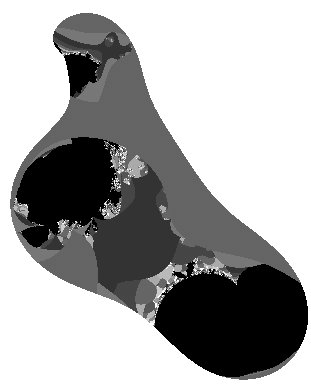
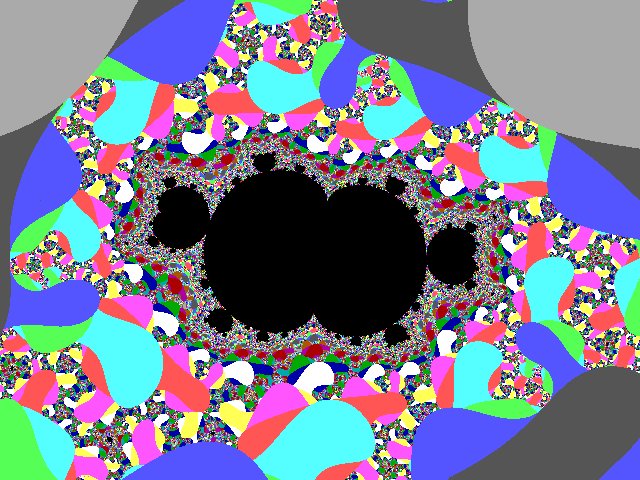
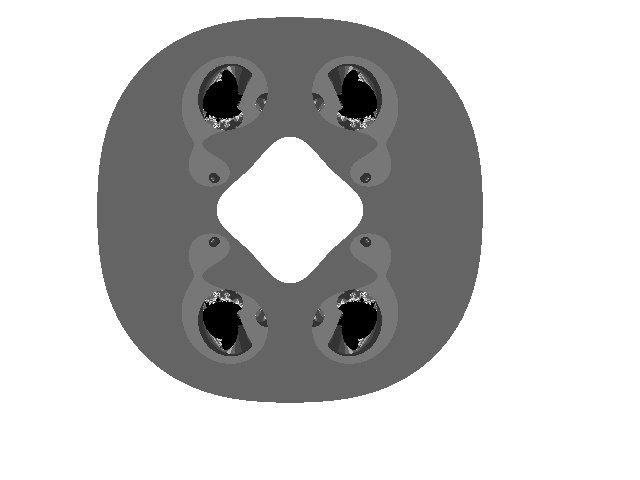
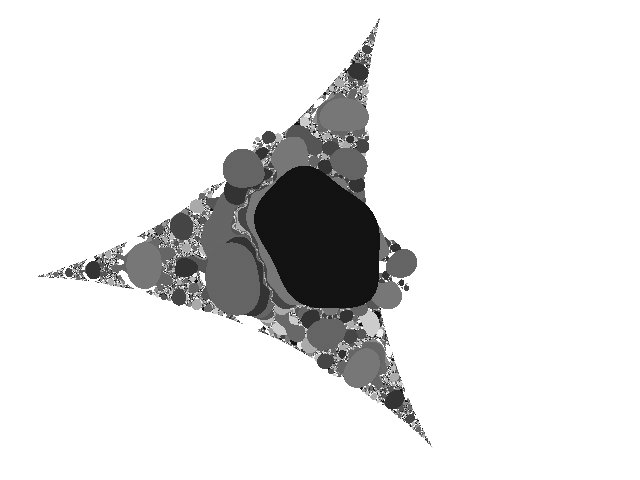
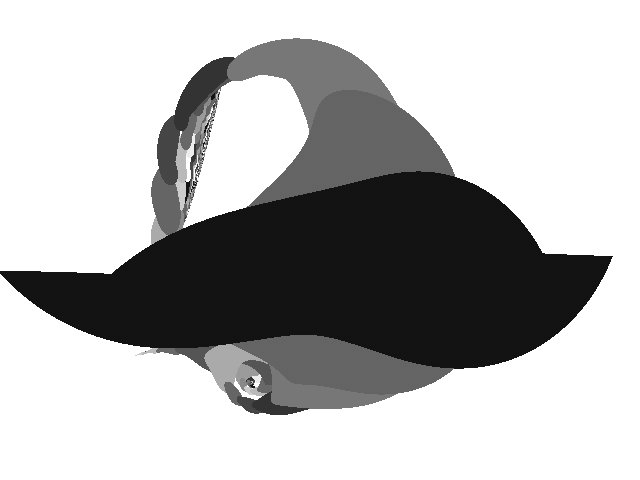
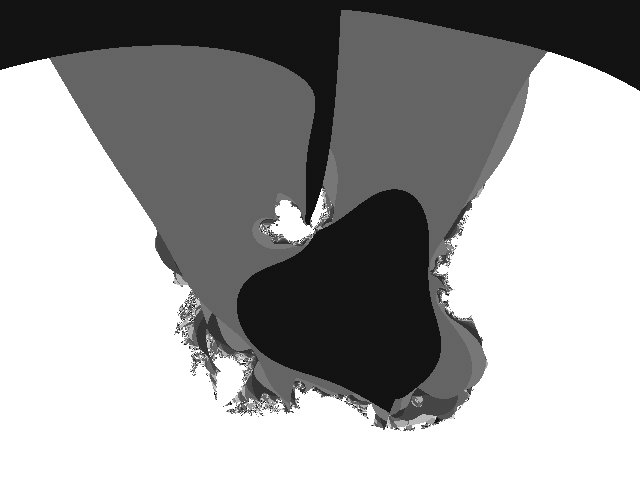


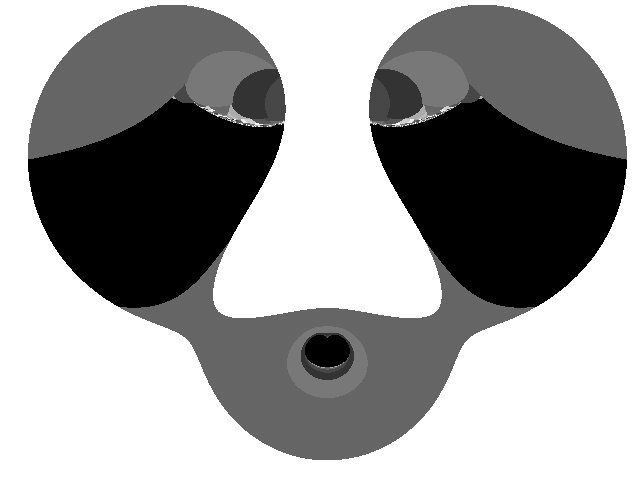

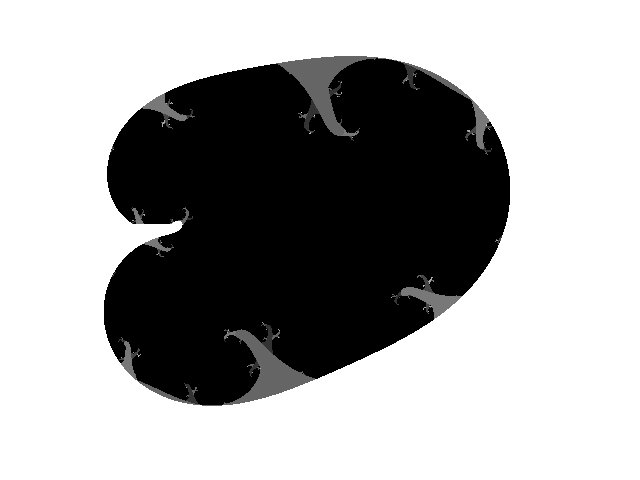
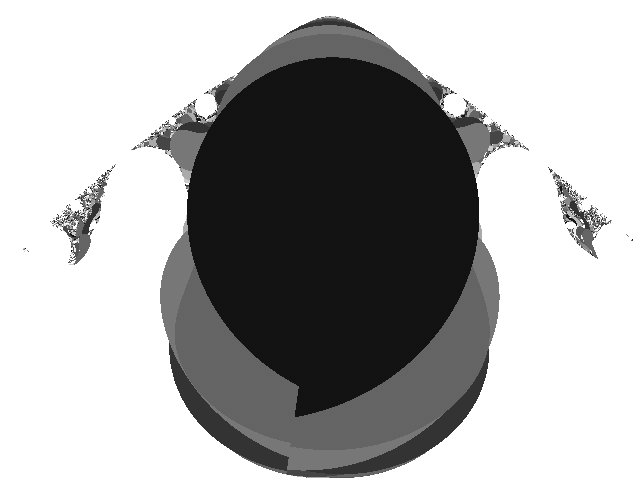
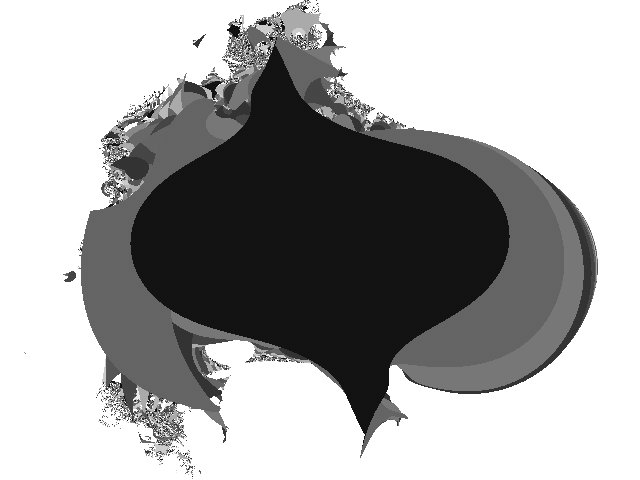
This page hosted by ![]() Get your
own Free Home Page
Get your
own Free Home Page